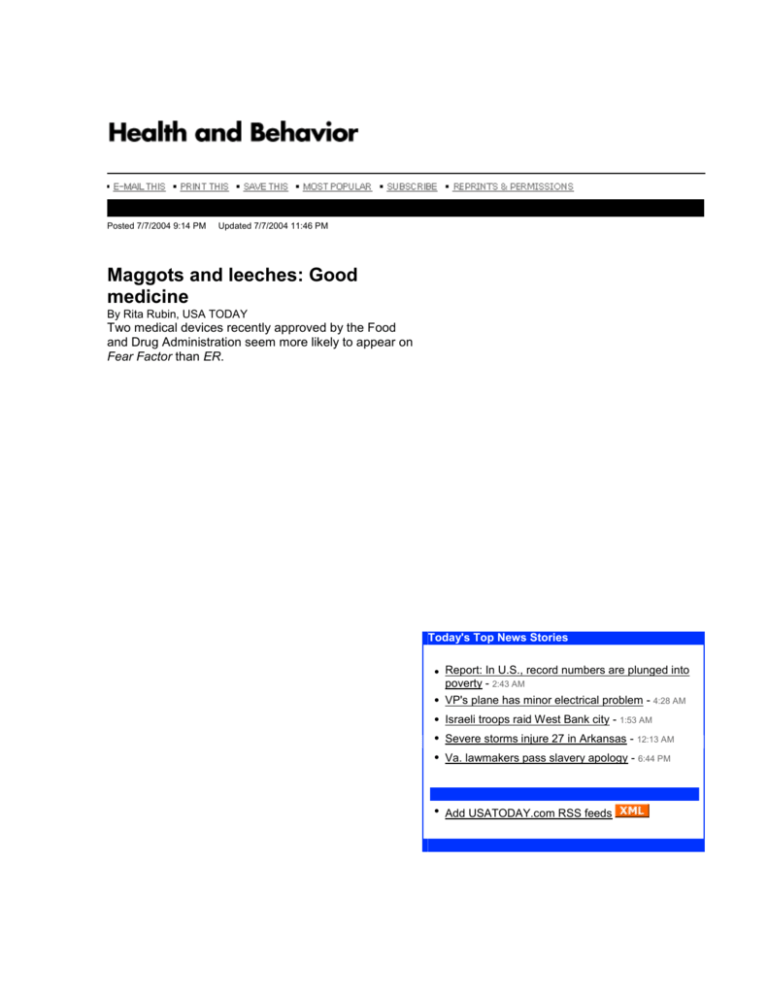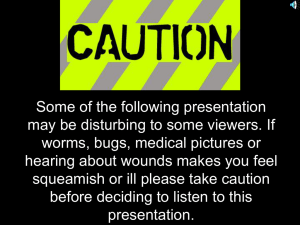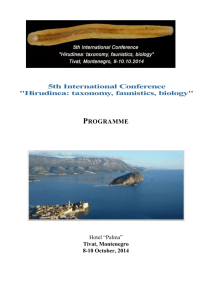File
advertisement

Posted 7/7/2004 9:14 PM Updated 7/7/2004 11:46 PM Maggots and leeches: Good medicine By Rita Rubin, USA TODAY Two medical devices recently approved by the Food and Drug Administration seem more likely to appear on Fear Factor than ER. Today's Top News Stories • Report: In U.S., record numbers are plunged into poverty - 2:43 AM • • • • VP's plane has minor electrical problem - 4:28 AM • Israeli troops raid West Bank city - 1:53 AM Severe storms injure 27 in Arkansas - 12:13 AM Va. lawmakers pass slavery apology - 6:44 PM Add USATODAY.com RSS feeds Your prescription is ready: Ohio pharmacist Greg Wellman shows off a container of medicinal leeches. By Tim Revell, Columbus Dispatch via AP Calling them "devices" is a stretch. But just like stimulators and stents, prostheses and pacemakers, leeches and maggots are now classified as FDA-approved medical devices — the first live animals to earn that distinction. No question, the thought of getting up close and personal with leeches or maggots is enough to make most healthy people feel ill. But patients who have been treated with these "devices," as well as their doctors, credit them with restoring health to tissue when high-tech medicine could not. Although a French firm's leeches were approved only last week and a California doctor's maggots were cleared in January, the creatures have long medical track records. Companies that were already selling leeches before the Food, Drug and Cosmetic Act became law in 1976 were grandfathered in and did not need FDA approval. The FDA only recently decided to regulate maggots, says internist Ronald Sherman, who earned the agency's permission in January to continue supplying the caterpillar-like fly larvae. Leeches through history Medicinal leeches are bloodsucking, aquatic cousins of the earthworm that hail from Europe. Doctors used leeches for bloodletting — thought to be good for whatever ailed patients — from Hippocrates' time through the mid-19th century. Leeches fell out of favor when doctors finally recognized that patients they bled fared no better, and often worse, than other patients. BAD TASTING MEDICINE Here's a remedy being tested for patients with inflammatory bowel diseases. It's a gastroenterologist's experimental concoction — spiced with 2,000 eggs of intestinal worms. A new treatment for inflammatory bowel diseases may be worming its way into the medical armamentarium. It's often trickier to connect veins, which carry blood back to the heart, than arteries, which carry blood from the heart. So before grafted tissue gets new vein growth, it can become congested with blood. Sometimes surgery can fix the problem, but if it can't, the graft might fail. Enter the leech. Not only does it suck out excess blood, but its saliva contains a powerful blood thinner. So even after it fills up and drops off, bleeding continues. University of Iowa gastroenterologist Joel Weinstock developed the concoction, which consists of a popular beverage — he declines to name it — and 2,000 pig whipworm eggs per serving. The worms come from pigs raised at a local U.S. Department of Agriculture facility and then slaughtered. Weinstock came up with the idea after observing that inflammatory bowel diseases are most common in industrialized countries, where modern sanitation had virtually eliminated the chance of people acquiring intestinal worms. Though that's generally a good thing, it might raise the risk of developing inflammatory bowel disease in genetically predisposed people, Weinstock says. That's because intestinal worms dampen the immune response, which is in overdrive in inflammatory bowel disease, causing persistent diarrhea, abdominal pain, weight loss and fever. Medications can relieve symptoms but aren't a cure. Weinstock chose to test pig whipworms because they don't venture out of the gut, they don't survive more than six or eight weeks and they don't appear to make people sick. Their eggs are less than half the size of a grain of sand, so they're basically undetectable in Weinstock's drink. The worms, which are less than half an inch long and thinner than a human hair, emerge in the gut. Douglas Chepeha, an ear, nose and throat surgeon at the University of Michigan, treats two or three patients a year with leeches after rebuilding faces or mouths decimated by cancer. Typically, leeches are used one at a time and replaced as they drop off — usually every 20 minutes — for 24 to 48 hours, then intermittently for a few days afterward, Chepeha says. "I've never had anybody refuse," Chepeha says. "They've come in with a serious cancer, they've had part of a critical organ removed, they want to get better. You say to them: 'I think this could help.' People have been amazingly stoic about it." Normally pretty squeamish, Alyssa Kieff, 22, of Marrero, La., tolerated five days of leech therapy in April. Kieff's beagle had snapped at her and tore off her right upper eyelid, which was reattached microsurgically by Kamran Khoobehi, a Louisiana State University Health Sciences Center plastic surgeon. Kieff, who returned to her receptionist job a month after surgery, wasn't quite as enthusiastic. Still, she says, "I knew it had to be done to help the eyelid survive. I didn't think about it." Two U.S. companies sell medicinal leeches for about $7.50 apiece. They're usually on call in hospital pharmacy refrigerators. Compared with leeches, maggots are tiny things. But their association with rotting flesh may make them even more off-putting than leeches — until you talk to someone who's been treated with them. Maggots to the rescue Weinstock has tested worm therapy in 120 patients with Crohn's disease or ulcerative colitis, the two types of inflammatory bowel disease, which affect up to 1 million Americans. The treatment was tolerated well and appeared to improve symptoms. "It's likely to be effective in both diseases," Weinstock says. He hopes to conduct a larger, multicenter trial of the therapy. By Rita Rubin Three years ago, a small cut on the bottom of Pam Mitchell's foot became seriously infected as a result of diabetes. After surgery to remove diseased tissue, Mitchell, who had worked as a waitress for 20 years, was left with a hole in her foot that was 1 inch deep and 2 inches across. And still, the infection raged. Antibiotics were powerless against it. "They were telling me I should think about amputation," says Mitchell, who is from Akron, Ohio. But then a co-worker told Mitchell of a TV show she had seen about using maggots to heal wounds. Desperate to save her foot, Mitchell found a dermatologist, Eliot Mostow, who thought maggot therapy was worth a try. Luckily, her insurance covered the $75-a-session treatments. Mostow applied disinfected maggots to her wound and covered them with a cagelike dressing. The maggots liquefied dead tissue, killed harmful bacteria and stimulated healing. After 48 hours, Mitchell's orthopedist removed the maggot dressing. After 10 treatments, her foot was well on its way to being healed. "It's amazing," she says. "There's hardly even a scar there." Today, Mitchell serves on the board of the non-profit Biotherapeutics Education and Research Foundation, which promotes the medical use of maggots and leeches and provides them to patients who lack insurance coverage. Sherman, an Irvine, Calif., internist, is the group's CEO and only U.S. maggot supplier. To say Sherman is mad about maggots is like saying Spider-Man 2 is doing OK at the box office. "He really is Dr. Maggot in my mind," Mostow says. "He knows more about this than anybody else." Through the years, Sherman says, military surgeons noticed that soldiers with maggot-infested wounds did better than similarly wounded soldiers without the infestation. Sherman began treating patients with maggots in 1990. By 1993, as word got out about his success in saving limbs scheduled for amputation, other hospitals began asking him for maggots. By 1994 or 1995, Sherman says, he was getting so many requests that he began charging a nominal fee to cover the materials and his time. Today, Sherman says, he supplies blow fly maggots to 300 sites around the country, including Washington Hospital Center in Washington, D.C., which used them to treat victims of the terrorist attack on the Pentagon. "They're lifesaving," says James Jeng, a burn specialist at the hospital. Sherman says relatively few of his customers are willing to go public. "Some administrators," he says, "have expressed the view that the public will think the hospital is old-fashioned or, worse, unhygienic."








